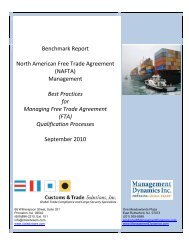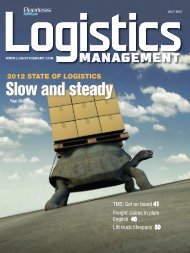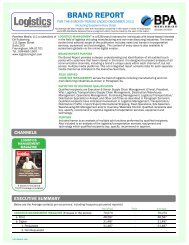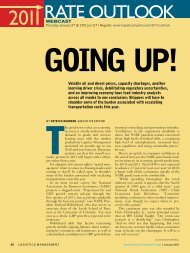Logistics Management - June 2010
Logistics Management - June 2010
Logistics Management - June 2010
You also want an ePaper? Increase the reach of your titles
YUMPU automatically turns print PDFs into web optimized ePapers that Google loves.
What to do about peak oil<br />
of global oil reserves, and national oil<br />
companies (NOCs) controlled only one<br />
percent.<br />
Today the tables have turned. IOCs<br />
control only six percent of the world’s<br />
proven reserves, and NOCs, like production<br />
giants Saudi Arabian Oil Company<br />
and National Iranian Oil Company,<br />
control 88 percent.<br />
As the price of oil rises, net oil<br />
exporters experience a significant boost<br />
to export incomes. NOCs generate<br />
petrodollars that support a variety of<br />
domestic investments that create jobs<br />
and increase domestic demand for<br />
energy and fuel. But here’s the rub:<br />
Most net exporting nations subsidize<br />
their domestic consumption.<br />
This market imperfection means<br />
that the real price of fuel in many of<br />
the exporting countries declines as<br />
the world price of oil rises. In 2005,<br />
the spot price for a barrel of oil was<br />
roughly $50. By 2008, the price had<br />
doubled to $100 per barrel. This doubling<br />
in price increased Saudi Arabia’s<br />
export earnings by nearly $400 million<br />
per day, and domestic oil consumption<br />
grew by 27 percent.<br />
Oil exports peak when the rate of<br />
growth of domestic consumption begins<br />
to outpace the growth of production. As<br />
a consequence of rising incomes and<br />
growing populations, domestic oil consumption<br />
is rising rapidly in many net<br />
oil-exporting nations. Indonesia provides<br />
a good example of the peak oil export<br />
phenomenon.<br />
Indonesia reached an oil production<br />
plateau in 1977 at just over 1.5<br />
million barrels per day (mbpd). By<br />
2000, production had declined slightly,<br />
but domestic consumption climbed<br />
steadily. Despite the elongated production<br />
plateau, oil exports clearly peaked<br />
in 1977, and in 2004 Indonesia transitioned<br />
from being a net oil exporter to<br />
a net importer despite the fact that the<br />
country was still producing at nearly 70<br />
percent of peak volume.<br />
A similar process is playing out in<br />
Mexico today. In 2004, Mexico was<br />
the number two supplier to the U.S.<br />
Between 2007 and 2008, net exports<br />
fell by 22 percent; and at the current<br />
rate of decline, Mexico will transition<br />
from being a U.S. supplier to a competitor<br />
by 2014.<br />
A similar process has played out in<br />
China—the most important non-oil<br />
trading partner the U.S. has. In 1993,<br />
China was a net oil exporter; but by<br />
2008, China was importing more than<br />
4.2 million barrels per day (mbpd).<br />
An even more unsettling trend<br />
emerges from an evaluation of exports<br />
by nation. While the total number of<br />
net exporting nations has remained<br />
relatively stable since 1996, the number<br />
of net oil exporters that have not yet<br />
reached peak exports declined from 39<br />
to 12. Important producers like Saudi<br />
Arabia, Mexico, Nigeria, Norway, and<br />
the U.K. are not on this list, but the<br />
Democratic Republic of the Congo,<br />
Iraq, Sudan, and Angola are. These<br />
are the nations on which the U.S.<br />
will become increasingly more dependent—a<br />
fact that does not impart warm<br />
and fuzzy feelings.<br />
So what does this mean for shippers<br />
and carriers Transportation practitioners<br />
should expect fuel prices to rise<br />
and become even more unstable. Smart<br />
practitioners should already be working<br />
on ways to reduce their consumption.<br />
This means focusing on optimizing<br />
transportation planning and utilization—not<br />
just trying to figure out ways<br />
to get better rates from carriers.<br />
Addressing the pending fuel shortage:<br />
Optimize, don’t just negotiate<br />
By Hank Mullen<br />
When it comes to building<br />
better LTL/shipper relationships<br />
these days, the<br />
old method of “I win you<br />
lose” just won’t cut it when you take the<br />
looming oil crisis into consideration.<br />
Americans should remember that<br />
when in crisis mode we have adopted<br />
the famous “Join, or Die” mantra that<br />
Ben Franklin used to unite the country<br />
before the Revolutionary War. I say<br />
why not unite the nation’s carriers and<br />
shippers when it comes to fuel I’ve<br />
been reading about “greening” for a<br />
few years now and I think the time has<br />
come to use our best and brightest to<br />
solve this pending crisis.<br />
It’s actually nice to see the government’s<br />
enthusiasm to get involved. One<br />
approach that has been offered by the<br />
Department of Transportation is their<br />
recently developed plan called “Transportation<br />
for a New Generation” that’s aimed<br />
at developing solutions for “livability.”<br />
And while my gut reaction would be<br />
to tell the government that it should let<br />
shippers and the greater transportation<br />
industry figure out how to get greener,<br />
it’s just not that simple.<br />
Unfortunately, shippers and carriers<br />
are focusing too much time negotiating<br />
fuel surcharges and not enough<br />
<strong>June</strong> <strong>2010</strong> | WWW.LOGISTICSMGMT.COM <strong>Logistics</strong> <strong>Management</strong> 31

















